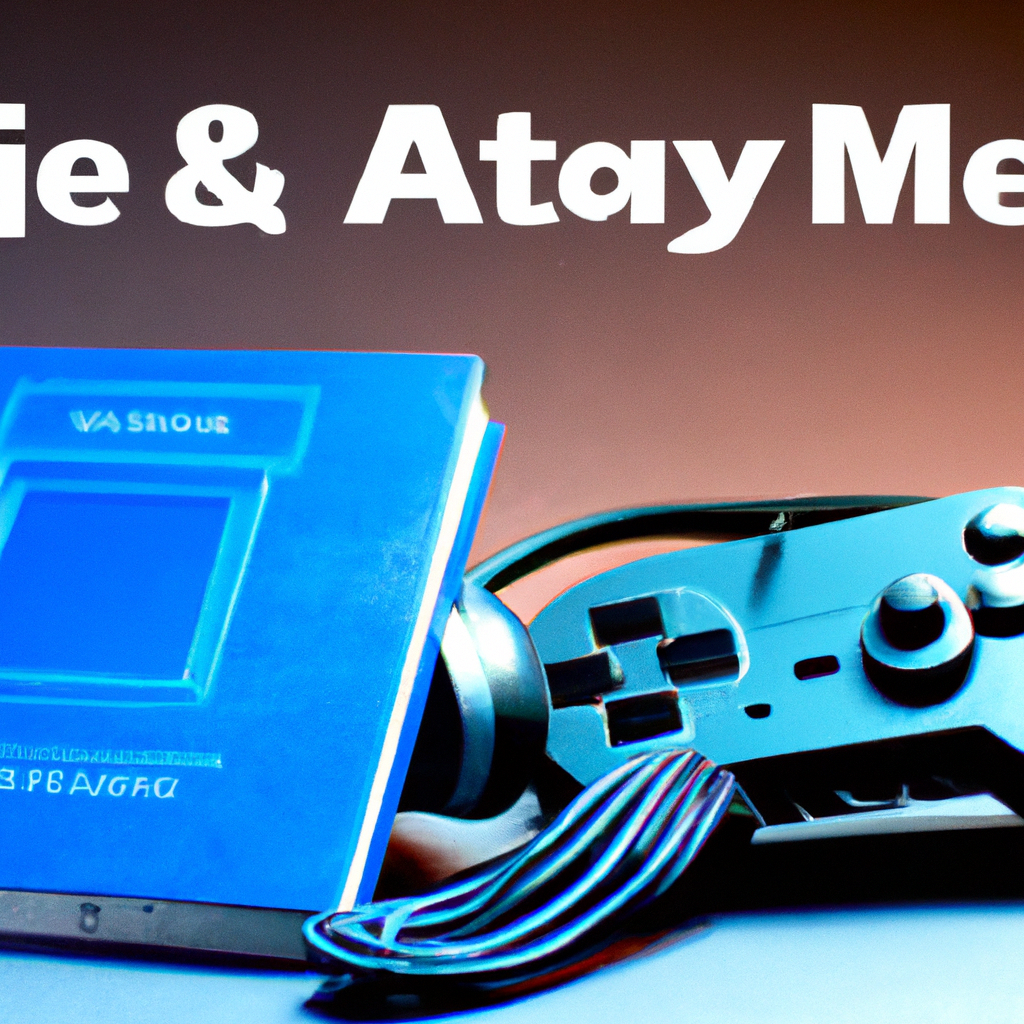Step into a time machine, fellow gamers, as we embark on a thrilling journey across the ever-evolving landscapes of the gaming world. Brace yourself for a unique experience of revisiting the bygone eras that have shaped our beloved pastime. Get ready to be teleported to the pixelated landscapes and immersive universes that have captured our hearts and sparked our imaginations. For in this article, we shall delve deep into the annals of gaming history, examining the trends and characteristics that have woven themselves into the fabric of each respective era. From the quaint simplicity of the early video games to the cutting-edge graphics of the present day, we shall uncover the treasures, the milestones, and the remarkable moments that have catapulted the gaming industry into what it is today. It is time to take a nostalgic trip and traverse the virtual realms of the past, present, and beyond, as we decode the game-changing trends that have shaped our favorite form of interactive entertainment. So strap on your armor, grab your controller, and let us embark on this thrilling expedition, where the past shall meet the present, in a quest to understand the captivating mysteries of gaming.

Understanding the Evolution of Gaming: From Retro Classics to Modern Masterpieces
Gaming has come a long way since the days of retro classics, captivating generations with its continuous evolution. Each era has brought new innovations and groundbreaking gameplay experiences, shaping the industry into what it is today. Let’s take a journey through time, exploring the transformative milestones that have propelled gaming from simple retro classics to complex modern masterpieces.
1. **Emergence of 3D Graphics**: One of the major turning points in gaming was the introduction of three-dimensional graphics. This breakthrough technology opened up a whole new world of possibilities, allowing developers to create immersive environments and visually stunning worlds. Games like “Super Mario 64” and “Tomb Raider” laid the foundation for the exploration-focused experiences we see in modern titles.
2. **Online Multiplayer Revolution**: The advent of online gaming revolutionized how players interacted with each other. The rise of the internet granted gamers the ability to connect and compete in virtual realms. From the early days of dial-up modems to the seamless online experiences we have today, multiplayer gaming has become an integral part of the industry. Titles like “World of Warcraft” and “Fortnite” have redefined the social aspect of gaming, fostering communities and friendships across the globe.
Revisiting Gaming Trends: Examining Shifts in Player Preferences and Genres over Time
In the ever-evolving landscape of gaming, trends come and go, captivating players in unprecedented ways. As years pass, the games we play and the genres we immerse ourselves in undergo intriguing transformations, reflecting the shifting preferences of players around the world.
One fascinating shift we have witnessed is the rise of open-world games, granting players immense freedom to explore vast virtual realms. These sprawling landscapes offer unparalleled immersion, allowing individuals to lose themselves in breathtaking environments and intricate storylines. Titles like “The Elder Scrolls V: Skyrim” and “Grand Theft Auto V” have captivated audiences, revolutionizing the gaming industry with their richly detailed worlds and endless possibilities. As gaming technology advances, so too does the potential of open-world experiences, promising even more breathtaking adventures in the years to come.
Uncovering Gaming Characteristics: Analyzing Graphics, Gameplay, and Storytelling Across Decades
Exploring the evolution of gaming is like embarking on an extraordinary time-travel journey, where graphics, gameplay, and storytelling have transformed dramatically over the decades. The earliest games, with their pixelated landscapes and simple mechanics, laid the foundation for what would become a multi-billion-dollar industry. Fast forward to modern times, where we are immersed in visually stunning worlds that blur the line between reality and virtuality, captivating our senses and fueling our imagination.
Graphics, as the visual representation of a game, have witnessed remarkable advancements. From the nostalgic 8-bit era to today’s hyper-realistic landscapes, game developers have pushed the boundaries of technology to create jaw-dropping visuals that transport players to breathtaking realms. Yet, it’s not just about eye candy. Engaging gameplay mechanics that challenge our reflexes, decision-making skills, and problem-solving abilities have evolved alongside graphics. Whether it’s exploring vast open worlds, solving intricate puzzles, or engaging in heart-stopping battles, the gameplay experience continues to evolve, offering a myriad of interactive possibilities.
Rediscovering the Past: Exploring Classic Games and their Relevance to Contemporary Gaming
In today’s ever-evolving gaming landscape, it’s easy to become enthralled by the dazzling graphics and immersive experiences of modern titles. However, there is great value in taking a step back and immersing ourselves in the timeless classics that laid the foundation for the games we enjoy today. Classic games serve as a reminder of the roots of the gaming industry, offering insights into the evolution of gameplay mechanics, storytelling techniques, and the overall artistry of game design.
One of the most intriguing aspects of exploring classic games is uncovering their relevance to contemporary gaming. While modern technology has undoubtedly revolutionized the medium, many of the fundamental characteristics found in classic games can be seen in today’s titles. Whether it’s the strategic decision-making of Chess influencing modern turn-based strategy games or the side-scrolling platformers of the past inspiring the likes of Super Mario Odyssey, classic games continue to shape the industry. By examining these influential titles, we gain a deeper appreciation for the tremendous creativity and innovation that stems from the past, ultimately enhancing our understanding of the present and future of gaming.
Key Takeaways
As we bid adieu to this exploration through the vast landscapes of gaming history, we are left with an overwhelming sense of nostalgia, mingled with a profound appreciation for the groundbreaking evolution that has transpired over the decades. Our sojourn through the annals of gaming’s past has been like traversing a labyrinth of virtual wonder, unearthing hidden treasures and witnessing the birth of extraordinary worlds.
From the humble beginnings of Pong and Space Invaders in the ’70s, we embarked on a journey that witnessed the birth of iconic characters, legendary franchises, and revolutionary gaming technologies. The ’80s brought forth an era of pixelated magic with Super Mario Bros and The Legend of Zelda, igniting our imaginations and shaping the future of console gaming.
With the ’90s came the renaissance of PC gaming, transporting us into the immersive realms of Doom and Myst, where our passions flourished amidst the rapid advancements in graphics and immersive storytelling. Then, the turn of the millennium brought us the dawn of a new era, as consoles grew more powerful and genres multiplied.
As we ventured into the 2000s, a golden age of gaming was unveiled. We encountered breathtaking epics like The Elder Scrolls: Morrowind and discovered the boundless possibilities of sandbox games through Grand Theft Auto: San Andreas. Shimmering with innovation, the era introduced us to the mesmerizing realism of HD graphics, online multiplayer platforms, and the advent of motion controls.
Now, as we navigate the glistening landscape of the 2010s and beyond, we find ourselves immersed in a gaming utopia that knows no bounds. Virtual reality has given wings to our dreams, while augmented reality has blurred the lines between fantasy and reality. From indie gems that touch our hearts to the cutting-edge experiences that redefine what it means to be a gamer, this era continues to astonish us with every new release.
As we conclude this riveting voyage through the corridors of gaming history, we are reminded that these games are not just pixels on a screen; they are portals to our imagination, catalysts for friendships, and archives of our shared cultural experiences. With each passing era, gaming has not only reflected the evolution of technology but also the collective aspirations, dreams, and emotions of humankind.
So, let us raise our controllers, keyboards, and touchscreens in celebration of the past, present, and future of gaming. Let us weave the threads that connect generations, transcend boundaries, and remind us of the boundless possibilities that lie within the realm of pixels and polygons. Until the next era unfolds, let us cherish the memories we have forged and eagerly await the adventure that awaits us in the realm of gaming’s tomorrows.
Since its inception, the video game industry has gone through an enormous transformation, as technology has advanced and popular trends have evolved. Each era of gaming has had its own unique characteristics that have set the tone for the industry at that time, and have helped to shape modern gaming as we know it today. In this article, we’ll take a look back at the different eras of gaming and explore the gaming trends and characteristics that have defined each one.
The first era of gaming can be traced back to the early 1970s, when the first home video game consoles hit the market. The earliest consoles, such as the Magnavox Odyssey and the Atari 2600, revolutionized the way people interacted with games. These consoles were limited in terms of graphics, sound, and control, which meant that the games were very basic and simple. However, they still managed to captivate millions of people who enjoyed spending their spare time playing these new games.
The 1980s marked a new era of gaming. Data storage and processing technologies had become more advanced, and this allowed game developers to create more complex and detailed worlds. Games such as Space Invaders, Pac-Man, and Donkey Kong were some of the most popular titles of the era and served as entry points into the world of console gaming for many people. These games defined the era, with their colorful graphics, iconic characters, and addictive gameplay.
The 1990s saw further advances in hardware and processing power that allowed developers to create even more sophisticated and detailed games. Games such as Super Mario World, The Legend of Zelda: A Link to the Past, and Street Fighter II became hit titles and pushed the boundaries of gaming. This era was also the birth of the fighting game genre, with many classic titles such as Mortal Kombat and Street Fighter II being released. The 1990s also saw the emergence of immersive 3D worlds, such as those found in the first person shooter games, such as Doom and Quake.
The 2000s marked the beginnings of modern gaming. With the rise of the internet and increased access to powerful processors and graphics cards, gaming became even more immersive and detailed. The early 2000s saw the beginnings of the open-world genre, with games such as Grand Theft Auto III and The Elder Scrolls IV: Oblivion setting the standard for this type of game. This period also saw the emergence of online gaming and the development of the MMORPG genre, with World of Warcraft becoming the most popular and successful MMO of all time.
Today, the gaming landscape is still changing and evolving. New technologies such as virtual reality (VR) and augmented reality (AR) are changing the way people interact with games, and mobile gaming is becoming increasingly popular. Despite all of the changes, the passion for gaming that has been present in each era still remains, and will continue to shape the future of gaming.



